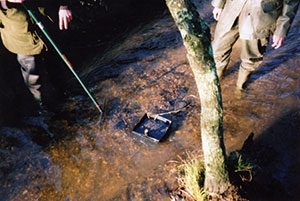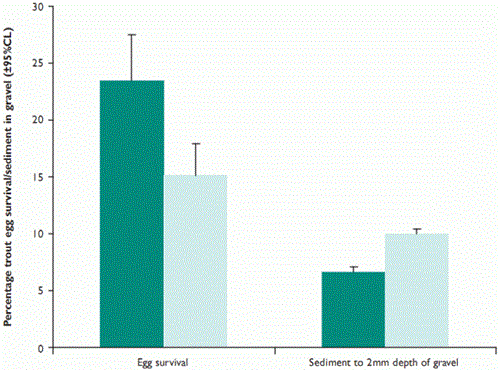 The deterioration of trout and salmon populations in UK rivers is a long-standing problem. Poor egg survival is believed to be a major contributory factor. It has been suggested that this is caused by the effect of increased sediment on conditions for eggs in the redds (nests) during incubation. Increased sediment load is believed to occur through changes in farm practice.
The deterioration of trout and salmon populations in UK rivers is a long-standing problem. Poor egg survival is believed to be a major contributory factor. It has been suggested that this is caused by the effect of increased sediment on conditions for eggs in the redds (nests) during incubation. Increased sediment load is believed to occur through changes in farm practice.
Trout and young salmon are typically residents of clean, fast-flowing streams that are well oxygenated and have areas of gravel substrate, which form the spawning grounds of the adult fish. The female constructs a redd in the gravel using her tail. The incubating eggs are totally dependent on river gravel conditions for their survival. Factors that can reduce survival include floods, which may dislodge the redd, predation within the gravel, and a deterioration in oxygen levels within the gravel caused by sediment load or organic pollution.
The amount of sediment in rivers depends on erosion occurring from land surfaces in the catchment and on river bank and riverbed sources. Transport is then by suspension or bed-load movement.
Some farming practices have been shown to increase bank-side erosion, leading to sediment deposition. It has been shown that simply fencing river banks can increase riparian vegetation, decrease erosion and even narrow the river. This study investigated the impacts of farm practice on river gravel conditions within streams and the impact of these conditions on trout egg survival. The results will provide guidance on what good farming practices can be used to reduce siltation and increase egg survival.
The study was based on eight catchments in North Cornwall, which are tributaries of the rivers Tamar and Neet. The area benefited from farm practice improvement initiatives generated by the Westcountry Rivers Trust and the catchments represented different levels of improved farm practice. The study was divided into three parts: a pilot study in 2002 to 2003 to investigate appropriate sampling methodology, a baseline study also during 2002-2003 to field-test the methods, and a main study in 2004 to 2006 to test relationships between trout egg survival, sediment deposition and farm practice.
Figure 1: Mean trout egg survival and sediment load in three fenced and three unfenced sites of North Cornwall, 2004-2006

In the main study (2004-2006), we placed eyed trout eggs in special mesh capsules in sediment baskets at sampling sites at the base of each of eight catchments. We measured survival, oxygen, temperature and sediment load at the end of incubation (six to 10 weeks) in each of the three years and collected data on the extent of farm plan improvements during the three years. We took physical measurements of the river at each site and obtained river flow data. In the autumn of each year we collected invertebrates at all sites and surveyed the bank habitat at four sites in the
final year.
The major influence on egg survival was reduced oxygen within the baskets buried in artificial redds owing to increased sediment. The farm practice of fencing river banks reduced sediment by 30% and improved trout egg survival by 53% (see Figure 1). We found that the majority of the sediment in the redds was derived from within the river gravel rather than from suspended sediments carried by the river. Trampling and grazing by cattle and sheep was the main reason why banks collapsed and local fencing brought about a major reduction in sediment movement to the redds with consequent improvements in trout egg survival.
Improvements in methodology and more detailed research are required, but this study has begun to address the complex relationship between livestock farming in a catchment and the impact this is having on streams. Most importantly, however, it shows that fencing river banks can be used to improve egg survival.
Acknowledgements
The Trust would like to thank the Westcountry Rivers Trust for funding this project.